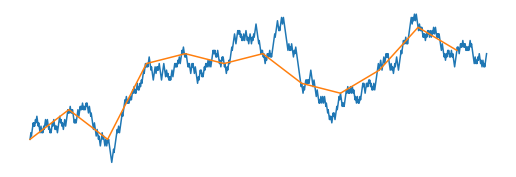We start with a vague question. Can one use the Brownian motion to sample the sum of i.i.d. random variables that converge to the Brownian motion?
This is a problem of embedding of random walks. It can be illustrated as follows:
Fig. - A random walk can be embedded in a Brownian motion.
The Skorohod embedding problem is the following: given a random variable \(X\) with finite second moment and zero mean, can one find a Brownian motion \((B(t),t\geq 0)\), and a stoping time \(T\) such that \( E(T) <\infty\) and \( B(T)\) have the same distribution of \(X\)?
Ever since it was proposed, in 1961, this problem has received at least 21 different solutions. The reason for continous refinements on this problem is its relation with the invariance principle. In a few words, the invariance principle states that any sum of independent random variables with finite second moment converges, after centering and rescaling, to the Brownian motion.
To see the power of this theory, we show how to obtain the Central limit theorem from the weak Law of Large Numbers in combination with the Skorohod embedding. Simply said, let \(Y_n = \sum_{i = 1}^n X_i\) be a sum of \(n\) i.i.d. mean zero random variables with \(E[X_1^2] = \sigma^2\). Now, if \(T_1\) is such that \(B_{T_1} =X_1\) and \(E[T_1]< \infty\) then,
\(E[T_1] = E[B_{T_1}^2] = E[X_1^2] = \sigma^2\).
Let \(B^{(1)}_t := B_{T_1 + t} - B_{T_1}\) and note that \(B^{(1)}_t,t \geq 0\) is again a Brownian motion. Let \(T_2\) be such that \(B^{(1)}_{T_2} = X_2\). We continue in this manner and define stopping times \(T_1,\ldots,T_n\) such that
\(B_{S_k} = X_1 + \ldots X_k = Y_k\) where \(S_k := T_1 + \ldots +T_k\).
Now, \(S_n = T_1 + \ldots +T_n\) and by the weak Law of Large Numbers \(n^{-1}S_n \to \mathbb{E}[T_1] = \sigma^2 \). Finally, note that the process \(W^{(n)}_t: = \frac{B_{nt}}{\sqrt{n}}\) is again a Brownian motion, that \(B_{S_n} = Y_n\) and, to obtain the CLT, observe that
\(\frac{Y_n}{\sqrt{n}} = \frac{B_{S_n}}{\sqrt{n}} =\frac{B_{n \frac{S_n}{n}}}{\sqrt{n}} = W^{(n)}_{n^{-1}S_n} \to W^*_{\sigma^2}\).
In this project you will study the classical Skorohod embedding problem and it's applications which include among others
Furthermore, this problems may be studied by different methods such as
Probability II.Prerequisites
Resources
